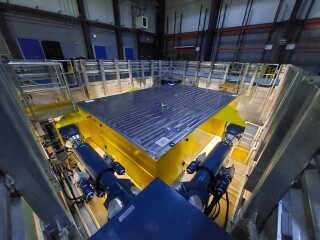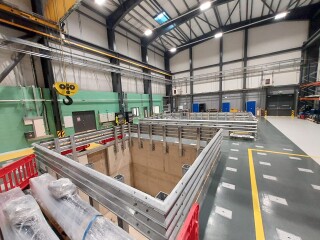Bristol’s Soil-Foundation-Structure Interaction (SoFSI) facility officially opens today, Thursday 27th January 2022.
The UK Collaboratorium for Research on Infrastructure & Cities (UKCRIC) SoFSI laboratory at the University of Bristol’s Langford campus has been funded by a £12m grant from the Engineering & Physical Sciences Research Council (EPSRC).
It will for enable large experiments – close to prototype scale –for use by both academics and industry.
This laboratory forms part of the first phase of the UKCRIC network of 13 universities delivering 10 national laboratories related to infrastructure construction. The total investment has been in excess of £150m over five years from 2016.
The SoFSI facility looks at how buildings and infrastructure interact with the ground when subjected to dynamic loads. The laboratory houses a four-metre (6m x 5m x 4m) deep soil pit for testing foundations, a 50-tonne capacity biaxial shaking table for dynamic testing of structures, and a smaller, high-performance, six-axis shaking table.
The large-scale test lab will allow research into how foundations, dynamic loading and soil interact. This research will inform improved design to maximise the resilience of infrastructure as well as the cost-efficiency of construction.

The lab has been designed specifically for research into five core areas: nuclear power plant soil-structure interaction, high speed rail, offshore wind turbines, monopiles and pile groups, and integral bridges.
Earthquake engineering professor Anastasios Sexos said: “Ensuring the long-term safety of critical infrastructure is paramount, particularly when it comes to building nuclear power stations or high-speed rail. The aim of this testing facility is to inform design that is not only safer but also cost-efficient. Investigating how buildings and infrastructure interact with the ground under natural and man-made hazards allows us to improve the smartness and resiliency of our infrastructure while at a lower financial cost and a reduced environmental footprint.”
Flavia De Luca, senior lecturer in structural and earthquake engineering, added: “We’re investing in state-of-the-art testing facilities that will help cut the cost of building the infrastructure of the future. For example, high speed rail will require many new bridges to cross waterways, roads, and other rail lines. SoFSI has been designed to help us understand, among other issues, how the span of lower cost, minimal maintenance integral bridges can be extended so that new high speed railway lines would be faster to construct, cheaper to maintain, more resilient to climate change, and enable us to minimise resource requirements.”
Got a story? Email news@theconstructionindex.co.uk




